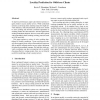Free Online Productivity Tools
i2Speak
i2Symbol
i2OCR
iTex2Img
iWeb2Print
iWeb2Shot
i2Type
iPdf2Split
iPdf2Merge
i2Bopomofo
i2Arabic
i2Style
i2Image
i2PDF
iLatex2Rtf
Sci2ools
IPTPS
2005
Springer
2005
Springer
Locality Prediction for Oblivious Clients
To improve performance, large-scale Internet systems require clients to access nearby servers. While centralized systems can leverage static topology maps for rough network distances, fully-decentralized systems have turned to active probing and network coordinate algorithms to scalably predict inter-host latencies. Internet applications seeking immediate adoption, however, must inter-operate with unmodified clients running existing protocols such as HTTP and DNS. This paper explores a variety of active probing algorithms for locality prediction. Upon receiving an external client request, peers within a decentralized system are able to quickly estimate nearby servers, using a minimum of probes from multiple vantages. We find that, while network coordinates may play an important role in scalably choosing effective vantage points, they are not directly useful for predicting a client’s nearest servers.
| Added | 27 Jun 2010 |
| Updated | 27 Jun 2010 |
| Type | Conference |
| Year | 2005 |
| Where | IPTPS |
| Authors | Kevin P. Shanahan, Michael J. Freedman |
Comments (0)

